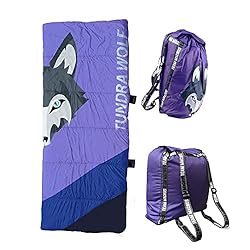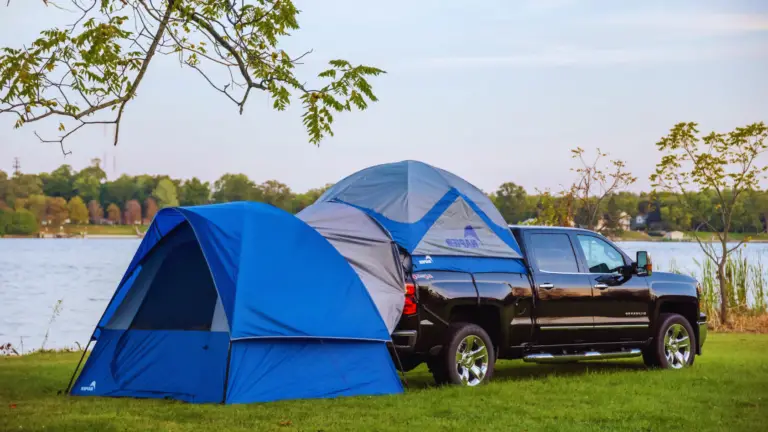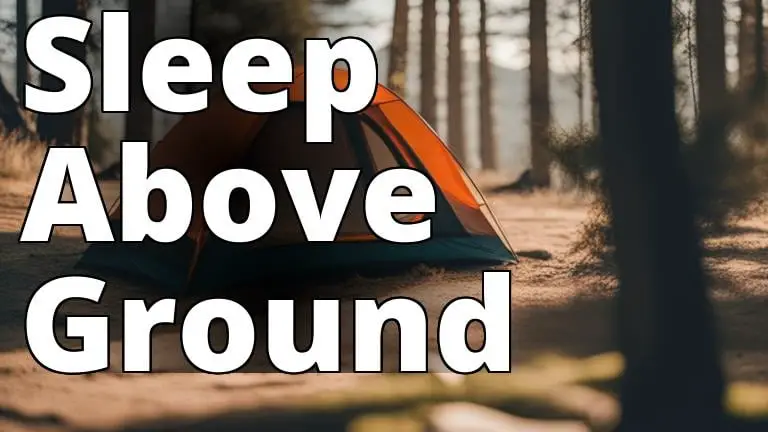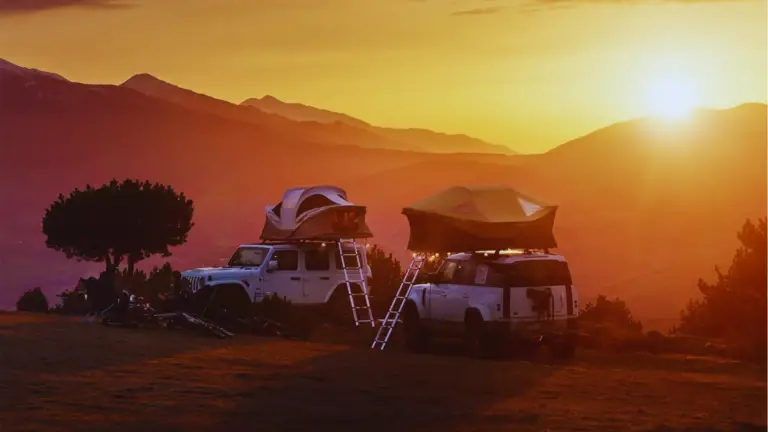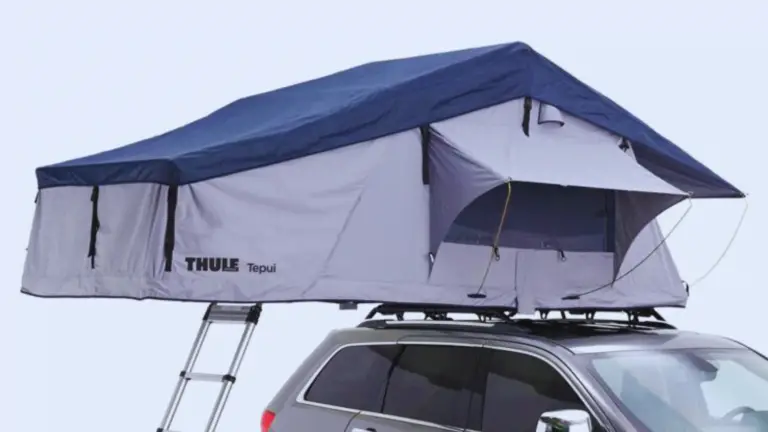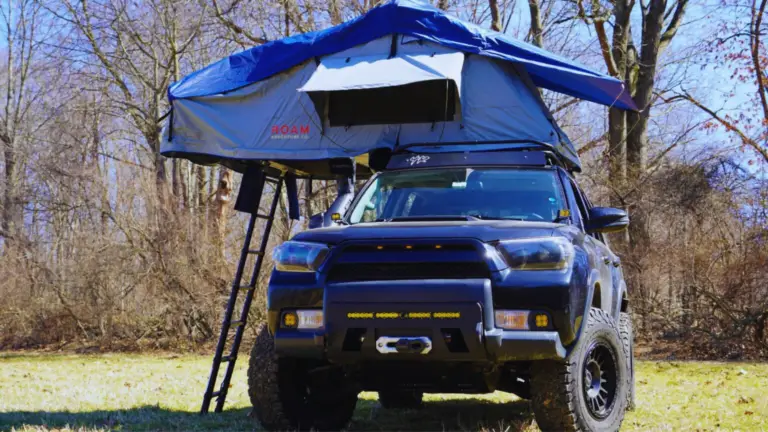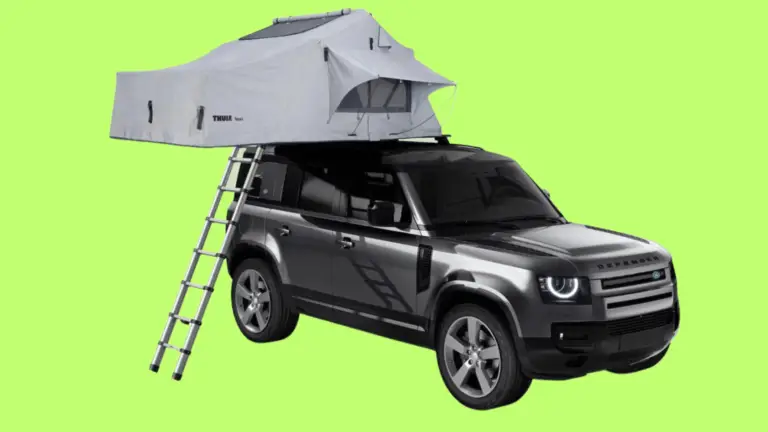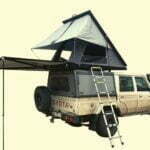In addition to being useful on family camping trips, a kids sleeping bag may be used on expedition excursions, at sleep-away camps, and at sleepovers with friends and family. Investing in a high-quality kid’s sleeping bag is a great way to protect their comfort and warmth during the night. Children’s sleeping bags range widely in length and minimum temperature rating, so it’s crucial to take your child’s size and intended use into account when making a purchase.
You can choose between down or synthetic sleeping bags. Synthetic fill is less expensive and more water resistant than down, yet it is also lighter and warmer than down. Summer-season, three-season, and four-season (winter weight) options are available, with three-season bags being the most versatile and appropriate for most uses. We’ve done the legwork and identified excellent options for a kids sleeping bag to help narrow down your search.
The next paragraphs will discuss our favorite kid-friendly sleeping bags.
Table of Contents
ToggleBest Kids Sleeping Bag: Comparism
Core Youth Indoor/Outdoor Sleeping Bag
Our ratings
- Can be used as a comforter
- Dries quickly when damp
- Comes with matching stuff sack
Teton Sports Celsius Bag
Our ratings
- Added padding around shoulders
- Moisture-wicking flannel liner
- Has internal pockets
Coleman Kids’ Sleeping Bag
Our ratings
- Fun design
- Has a “roll control” system
- Has thermolock draft tube
Kelty Kids CloudLoft
Our ratings
- Cozy synthetic insulation
- Offset quilt construction
- Spacious footbox
AceCamp Kids’ Sleeping Bags
Our ratings
- Glow-in-the-dark design
- Youth size
- Elastic style hood
Big Agnes Little Red
Our ratings
- Useful sleeve design
- Loops at the end
- Easy to transport.
Coleman Plum Fun Youth Sleeping Bag
Our ratings
- Accommodates children
- Cute honey bee design
- Value for money
Happy Nappers Sleepy Sack
Our ratings
- Cute design
- Comes with matching stuff sack
- Machine washable
Tundra Wolf Kids’ Sleeping Bag
Our ratings
- Stuff sack is designed for kids
- Equipped with carrying straps.
- Includes cleaning instructions.
Morrison Little Mo Sleeping Bag
Our ratings
- Meets AAP safe sleep guidelines
- Unzips from the bottom
- Suitable for babies
Best Kids Sleeping Bag: Review
1. Core Youth Indoor/Outdoor Sleeping Bag
This classic children’s sleeping bag comes in a variety of vibrant colors and is just the appropriate weight for summer camping.
The bag can be opened at the bottom to let in some additional cool circulation on hot summer evenings and is designed to fit kids up to 5 feet tall.
This bag’s amazing feature is that it can be joined with another to provide a bigger sleeping area. Kids that like extra space while napping would appreciate this. This is also a great idea if you’re taking two kids camping and one of them would feel safer having their sibling in the back pack with them.
What we like
- Fully unzips to become a blanket.
- It's easy to dry after becoming wet.
- For convenient portability and storage, a matching stuff pouch is included.
What we don't like
- Definitely not enough warmth for the coldest of nights.
2. Teton Sports Celsius Junior Kids’ Bag
According to Teton Sports, this one is great for vehicle camping, backyard getaways, and other mild-weather excursions.
It includes a cowl that curves up to keep your head off the ground and your cushion in place.
You and your child will appreciate the lined zipper, which removes the hassle of the liner getting caught.
What we like
- Padding and a zipper block drafts.
- Soft, toasty, moisture-wicking brushed flannel lining.
- Internal pockets hide a flashlight and munchies.
What we don't like
- You can't unzip it completely to get a flat blanket.
3. Coleman Kids’ Sleeping Bag
There’s a good reason this Coleman bag is so well-liked among parents shopping for a sleeping bag for their child. They find the fact that it lights up in the dark to be really appealing.
It’s an acceptable compromise between lightweight sleeping bags and those designed for extreme conditions.
This is great for campers, sleepawayers, sleepovers, and those who want to camp in their own backyards.
What we like
- Kid-friendly design.
- The "roll control" technology makes it easy for kids to roll up and pack their sleeping bag.
- Thermolock draft tubes keep your kid warm and cozy.
What we don't like
- This sleeping bag didn't wash well.
- The zipper might snag at the corners.
4. Kelty Kids Mistral 30
This mummy-style sleeping bag is perfect for kids. In terms of quality, this bag was right up there with the Kindercone. This tote is perfect for the somewhat older or larger youngster. We know you’ll find it to your liking.
The Kelty Mistral has a soft fill and a silky lining, making it warm, well-structured, and incredibly comfortable. In addition, it is quite easy to clean up after being soiled by sticky substances like s’mores and apple juice, which were accidentally stowed away in the bag and slept on during the testing phase. It was as good as new after a brief spin in the washing machine’s mild cycle. With a price tag of around $50, this kids’ sleeping bag is a terrific option if you’re seeking for a long-lasting and technically advanced option.
This bag’s sturdy structure and high-quality materials ensure that it will outlast several growth spurts. The hood is padded at the crown to keep in heat on cool evenings, and it has an adjustable drawcord at the top and bottom to tighten it for maximum coziness.
The Kelty Mistral is notable for its extra-long footbed, which measures 19 inches in length from the bag’s bottom to the bottom of the two-way zipper. For younger children, this can be a major inconvenience, but for older children it could be a convenient place to keep their clothes and water bottles.
It’s also available in two adorable hues, can be purchased at a great price, and is a good fit for children (and adults) up to around 5 feet in height.
What we like
- Warm artificial insulation.
- Large footbox and offset quilt.
- Includes storage bag for easy transport.
What we don't like
- Might not fit kids taller than 5'6.
5. AceCamp Kids’ Sleeping Bags
A child may sleep comfortably in the AceCamp because of its distinctive wave structure, which traps body heat and provides ample space for movement.
The hood and front zipper make it simple for children to put on and take off their own sleeping bag.
It also prevents children from waking up in the night by climbing out of the opening at the top of their sleeping bag.
What we like
- Bright constellations design.
- The youth-size suits campers up to 5 feet 4 inches tall, longer than typical kids' sleeping bags.
- Elastic hood means no tangle-prone cords.
What we don't like
- Children size fits up to 4 feet 8 inches.
6. Big Agnes Little Red
The Big Agnes Little Red Sleeping Bag is the lightest and most comfortable option for youngsters, but it also costs more. The fact that it weighs so little makes it an excellent option for families where the kids will be responsible for transporting their own equipment.
Your kid will be warm thanks to the shaped hood, and they won’t fall off their sleeping pad because of the sleeve that is built right in.
This tough kid’s sleeping bag might be just what you need for year-round camping.
What we like
- Back of the sleeping sack fits sleeping pad. This prevents your toddler from slipping off the mat.
- Sleeping bag loops allow for holding.
- Easy to travel at 7.5 x 9 inches.
What we don't like
- Fits kids up to 4'5"
- It doesn't keep incredibly warm, so your children could complain in the winter.
7. Coleman Plum Fun 45 Youth Sleeping Bag
Coleman’s kid’s sleeping bags are as reasonably priced as the rest of their camping gear. If you’re searching for a first sleeping bag or want one that won’t break the bank but will still receive plenty of usage during sleepovers and summer campouts, consider the Plum Fun 45.
Your children will love the glow-in-the-dark pattern, and they’ll appreciate the hidden pocket for their flashlight.
What we like
- Kid-friendly honey bee and honey container design.
- It's inexpensive and lasts for several trips.
What we don't like
- It's not warm, thus it's best for summer or indoor camping.
- It's difficult to roll and repack.
8. Happy Nappers Pillow & Sleepy Sack
A toddler’s sleeping bag is just as likely to be used for naps at daytime as it is for a night under the stars in the wide outdoors.
As a parent who has had two children in daycare at once, I know the value of a sleeping bag that can withstand several washings in the washing machine while still maintaining its cozy interior. And that’s why I think you’ll like this back pack from Happy Nappers.
The stuff sack, like the bag itself, features a lovely pattern and is comfy when placed on top of a mattress topper.
What we like
- Baby and kids love the adorable style.
- Includes a convenient carrying case for storage.
- Washable in a washing machine.
What we don't like
- Possible incompatibility with subfreezing conditions.
9. Tundra Wolf Kids’ Sleeping Bag
What we like
- Kids may push the bag inside the stuff sack without rolling it first.
- The sack has straps that make it a backpack.
- Kids have cleaning instructions, so they have no excuse for dirty sleeping bags.
What we don't like
- Glow-in-the-dark zipper fades quickly.
10. Morrison Little Mo Sleeping Bag
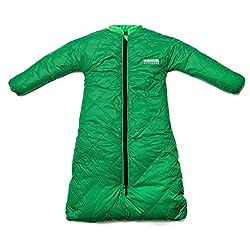
The down-filled draft tube blocks the air from getting in, the footbox is tight, and the fleece zipper flap keeps the zipper away from sensitive skin. Some of the things that set the Morrison Little Mo distinct from other infant sleeping bags are the ones listed above.
Some products marketed as “baby sleeping bags” are really normal usage sleep sacks made specifically for your infant. However, a baby should not use a sleeping bag intended for outdoor usage in a warm indoor environment.
What we like
- It's safe by American Academy of Pediatrics standard
- The bottom zipper makes diaper changes easy.
- Easy to travel at 7.5 x 9 inches.
What we don't like
- It's not a baby sleep sack.
- Your toddler may outgrow the sleeping bag quickly.
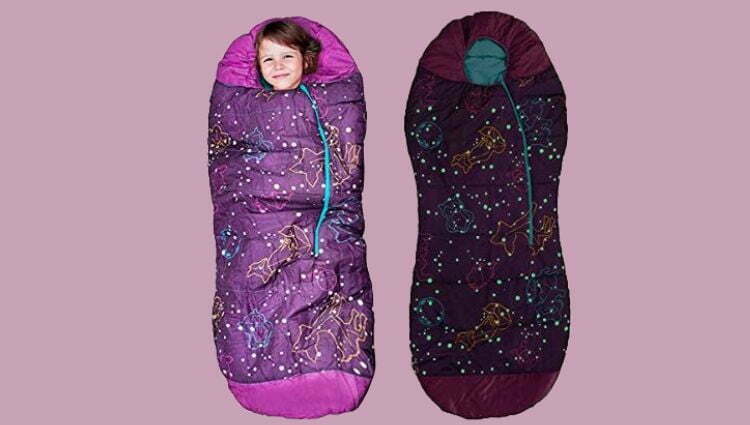
How to Choose the Best Kids Sleeping Bag
When shopping for a sleeping bag for your kid, the first question you should ask is what he or she plans to use it for.
It may seem obvious, given that they’ll be sleeping in it, but varied conditions call for different types of sleeping bags. If you’re planning a sleepover for your kids, you’ll want to pick out a different sleeping bag than the one they’ll need for a camping trip.
If your child will be sleeping in a warm house during a sleepover, he or she does not need a very warm sleeping bag. To keep kids warm while they sleep in unheated cabins at summer camp, you’ll need to select a sleeping bag that meets the recommended temperature rating.
Your youngster needs a sleeping bag suitable for outdoor camping, which means one with a lower temperature rating.
Assuming you now know where your child will be sleeping and how warm they need to be, you can go on to the other considerations.
Read our Best Cheapest Roof Top Tents.
Perfect Size for Sleeping Bag:
Your child’s sleeping bag comfort depends on the length of the sleeping bag. Choose a sleeping bag that is just the right size for you. However, if you pick the correct one, kids may outgrow it really soon.
It’s also important to think about the form. Warmer is a sleeping bag that tapers toward the feet, but if you have a youngster that sleeps like a starfish, a more conventional rectangular shape will be more comfortable.
Space in the Head:
The greatest children’s sleeping bags typically include a hooded design, especially those priced more. You may use this to secure a pillow in place or wrap it snugly around your head on cold nights. It’s a good idea in general, but if your kid plans to sleep under the stars, that’s a must.
Exterior Coating Composition:
Most kids’ sleeping bags are made with a polyester outer shell and a polyester/taffeta blend within.
In case water resistance is an essential characteristic for your case, you may want to look at a few different shells.
Insulation:
Synthetic insulation is resistant to moisture and cold. While it performs a better job of keeping you warm while it’s dry, down, insulation becomes heavy and unusable when it gets wet.
You may get into trouble if your kid throws up in their sleeping bag or is all over Dad and the tent at 2 in the morning after eating too many s’mores. When I say this, it comes from personal experience.
Zippers:
Do the sleeping bag’s zippers come with liners that keep the lining from getting caught in the zipper? If your child will be sleeping in their sleeping bag unattended, this may be an essential consideration. Being able to get out of a sleeping bag quickly is also important for answering nature’s call.
How to Clean a Kid's Sleeping Bag
If you’re worried about washing your kid’s sleeping bag too often, don’t worry. If you wash your sleeping bag in the washing machine too often or do it incorrectly, the quality of the materials might deteriorate, causing the bag to lose its insulating properties.
Instead, use a toothbrush and some soapy water to spot-clean stained spots. Remove any stains or soiled spots from the sleeping bag without submerging it in water. You may also use baby wipes. When cleaning and rinsing these places, be careful to avoid getting the insulating material wet, and then let the sleeping bag dry naturally. Avoid using an agitator or fabric softener if you must machine-wash your child’s sleeping bag.
You should wash your bag in a technical fabric soap, such as Nikwax’s Down Wash Direct for your down bag and Nikwax’s Tech Wash for your synthetic bag. Wash the sleeping bag on the gentle cycle or by hand for best results.
Best Kids Sleeping Bag: Final Thoughts
While there are many aspects to consider when choosing the finest kids sleeping bag for your child, the Core Youth Indoor/Outdoor Sleeping Bag is a safe bet for basic summer tent camping and sleepovers.
- Best Kids Sleeping Bag for Warm Weather – Core Youth Indoor/Outdoor Sleeping Bag
- Best Kids Sleeping Bag for Camping – Teton Sports Celsius Junior Kids’ Bag
- Best Kids Sleeping Bag for Summer Camp – Coleman Kids’ Sleeping Bag
Kids Sleeping Bag: FAQs
Q. Where can I begin looking for these materials?
Down and synthetic fillings are the two options for sleeping bags, as stated by Whitman. Natural fillings like down are more costly and less water-resistant than their synthetic counterparts, even though they are warmer and lighter than synthetic alternatives. Even a small amount of moisture makes sleeping in a down bag exceedingly uncomfortable. Given that most children outgrow their sleeping bags within a few years, I would advise purchasing a synthetic one because they are more long lasting and cost effective.
Q. What is the logic behind temperature ratings?
The warmth of sleeping bags may be gauged by their temperature ratings, as explained by Whitman. European Norm (EN) and ISO (International Organization for Standardization) are the two most prominent normative bodies (ISO). Comfort rating (the lowest temperature at which a chilly sleeper will feel comfortable) and Low Limit Rating are two of the most common ratings seen on bedding. As one might expect, the Low Limit is always set to be lower than the Comfort Rating. Bags for the summertime often have a rating of 30 degrees F or higher. The temperature range for three-season bags is between 15 and 30 degrees Fahrenheit. Additionally, four-season bags are usable down to temperatures of 15 degrees Fahrenheit.
Q. Are sleeping bags safe for children?
Sleeping bags provide a suffocation risk for children under the age of three. Therefore, parents shouldn’t put them to bed with them. A baby sleeping bag, which acts like a wearable blanket, is what should be used instead. That way, your baby’s head can stay out of harm’s way and he or she may sleep comfortably all night long.









